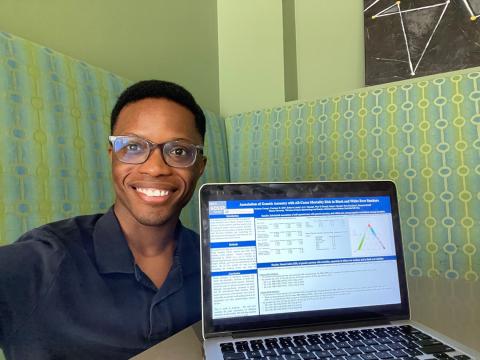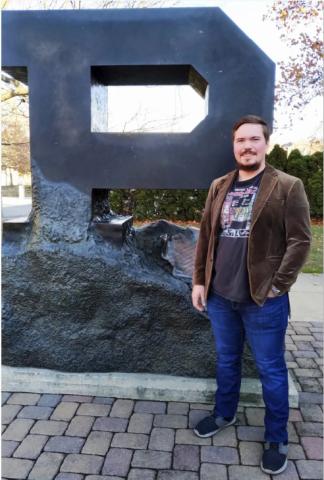Science Summer
SIP Students Wrap Up Season of Learning

A great place for learning and networking. A place that truly cares about its employees.
That’s some of the feedback from students in the Summer Internship Program (SIP), who recently wound down their research projects after 12 weeks of immersive lab experience. SIP, run by the Office of Intramural Training and Education, is open to college, graduate and professional school students. There are also several SIP subprograms for high school students.
NIH typically hires about 1,200 SIP students every summer, although this number has fluctuated in the past 2 years due to the ongoing Covid-19 pandemic. SIP couldn’t onboard any students in 2020 and could only offer a virtual program in 2021.
For the first time in 2 years, though, many students were able to attend in person. Some restrictions were still in place, such as social distancing and optional masking, and students occasionally completed work from home when their duties allowed it. Some students were still fully virtual, but most needed to attend in person to run experiments and learn lab skills.
“There’s definitely something to be said about being in the physical lab environment,” said Noah Pinson, a high school SIP student in the HiSTEP 2.0 subprogram. He interned in the Clinical Center’s radiology and imaging sciences department (RISD), collecting patient data to better understand the clinical outcomes and characteristics of bilateral multifocal renal oncocytoma. He also had 5 years of volunteer experience with the Children’s Inn prior to this summer.
Grigorii Rudakov, a student in the Graduate Summer Opportunities to Advance Research (G-SOAR) program and a self-described extrovert, was also pleased to be working in person. He interned in the Laboratory of Single Molecule Biophysics within the National Heart, Lung and Blood Institute, using “magnetic tweezers” to study supercoiled DNA and the effects of the topoisomerase IV enzyme.
“I prefer to work in person,” he said. He is a passionate researcher and hard worker who pulls long hours in the lab, so in-person work was ideal for his work habits.
A subset of interns still worked virtually this summer. One is Dontray Crump, a grad student in the Graduate Data Science Summer Program (GDSSP) with the National Cancer Institute. He uses R-Studio, a computer program for statistical computing and graphics. He worked in the Biostatistics Branch of the Division of Cancer Epidemiology and Genetics, examining the association of genetic ancestry with lung-cancer risk, controlling for lung-cancer risk factors and self-reported race/ethnicity, using the PLCO (prostate, lung, colorectal and ovarian) cancer screening trial.
Crump expected the summer to be fast-paced and competitive, but he quickly found that “there is a lot of contribution and collaboration,” regardless of physical work status.
“There is always help when you need it!” he added.
Positive learning experiences were a common theme across the board.
“I don’t want to leave,” Magdalena “Mags” Macias laughed. She was an Amgen scholar, part of an international program that hosts undergraduate students at 24 research institutions (including NIH). A research background is not a requirement for the program and Macias landed a position in a neuroscience lab in the Eunice Kennedy Shriver National Institute of Child Health and Human Development with no prior neuroscience experience.

In her research project, she studied the role of the integrated stress response (ISR) in traumatic brain injury (TBI), and how ISR inhibitors may serve as a therapeutic target that will lead to cell survival after a mild TBI.
Macias offered encouragement for students who think they might not be cut out for research: “If you don’t try, you’ll never know!”
Another student who is familiar with trying is Janaylin Carela. A recent high school graduate in the HiSTEP 2.0 program, she initially applied to HiSTEP in her junior year and was not accepted. She credited her mother with encouraging her to apply again, and Carela’s second application was rewarded with success.
To anyone who has experienced a similar setback, she said, “Please keep trying. You never want to be [left] wondering ‘What if I had…?’”

NIH and other institutions are looking to improve minority health and decrease health disparities, and this summer’s SIP interns expressed interest in addressing these issues in their current and future research.
Carela’s research with the National Institute of Dental and Craniofacial Research focused on periodontitis, an invasive and inflammatory gum disease that disproportionately affects disadvantaged communities that may be unable to access regular dental care.
Crump expressed his desire to “[use] statistics in a governmental sector focusing on minority health and health disparities…to improve and save lives from both a population and individual level.” His summer research on lung cancer risk factors was also on par with his career goal.
And Macias explained how the “interdisciplinary aspect of medicine is where you can make the most change.”
As NIH’s students head off to their respective colleges and universities, they take with them invaluable research and interpersonal skills.
Some students, like Carela, are already considering how they can return to NIH in the future.
“[SIP] has been one of my best experiences all summer,” she explained. “NIH helps you grow as a person.”
